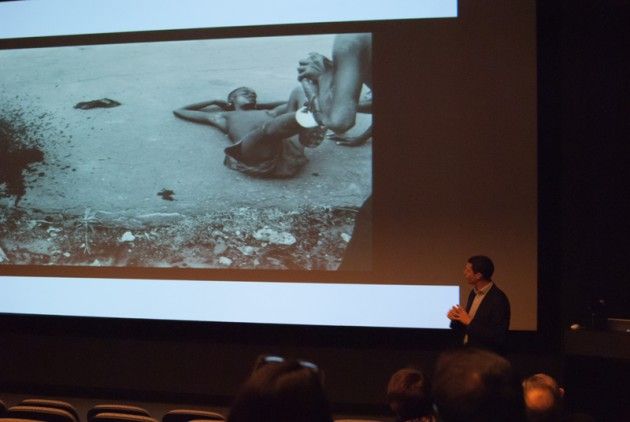Portraits of War: Tim Hetherington Talks on Photographing War
Living in the comfortable haven that is Hamilton, N.Y. can certainly separate a person from the world at large. On February 21, however, dozens of students and faculty gained new perspectives on critical issues around the globe after attending the lecture “A Photojournalist in War Zones: West Africa and Afganistan,” featuring esteemed photographer and filmmaker Tim Hetherington.
Hetherington is best known for his artistic depictions of both the Liberian Civil War in the ’90s and the current conflict in Afghanistan. Before embarking on either of these adventures, Hetherington began his career in publishing, though he was always interested in the visual world.
“I discovered pictures much later in my life,” he said. “Photography set me free and allowed me to get out of an office and actually meet people.”
Hetherington removed himself as far as possible from an office setting, as he began his first international project photographing a Liberian soccer team.
Hetherington remained in Africa, moving north to Sierra-Leone and working at a school for the blind. Many of the students were victims of conflict and political unrest in the country, and had plastic melted into their eyes by members of militias and rebel groups. Hetherington photographed these children and their tragedies.
“Pictures do not just represent things on the surface. They have emotionality to them. I was trying to get inside these people, to get an experience of what being blind feels like. These pictures have a visual and emotional life,” he said.
Hetherington concluded his eight-year stay in Africa photographing the Liberian Civil War. He presented disturbing pictures of young boys holding guns in streets, groups of people looting and men from rebel groups assembling firearms.
“Often pictures upset you because they show you something you did not expect or something that you do not want to think about,” Hetherington said.
During his time in Liberia, Hetherington became interested in the concept of young men in conflict, which was the central focus of his next project photographing American soldiers in Afghanistan. His pictures were not just of war and violence, but also depicted the personalities of the soldiers themselves.
“Often when you see the soldiers fully dressed in their uniforms, we feel a distance between them. They become a symbol, though we don’t actually know who they are. I wanted to create a body of work that was personalized, that builds intimacy between the viewer and the soldier,” Hetherington said.
The most memorable pictures of the collection showed the soldiers’ interaction with one another, illustrating the close relationship formed between them.
“These men may have completely hated each other, but would ultimately die for each other. We’re not talking about friendship, but about brotherhood,” he added.
Hetherington spent his time in Afghanistan not only photographing the soldiers, but filming for a documentary as well, which included new responsibilities.
“I became an investigator. Eventually I realized the experiences I witnessed in the field as a documentarian were really valuable because it was all first-hand,” he said.
His footage was compiled to create the documentary Restrepo, which follows a specific platoon of soldiers, depicting their struggles overseas. The film has been nominated for an Academy Award for Best Documentary.
Hetherington has experienced different forms of conflicts in different areas of the world, and provides his followers opportunities to understand these events through visual outlets. However, Hetherington admits that it is ultimately up to us to determine how we will perceive a picture.
“Photographs have the amazing power to visually engage viewers. We all carry a visual library in our heads that is very complex, and seeing new images can open up theses libraries,” Hetherington said.







